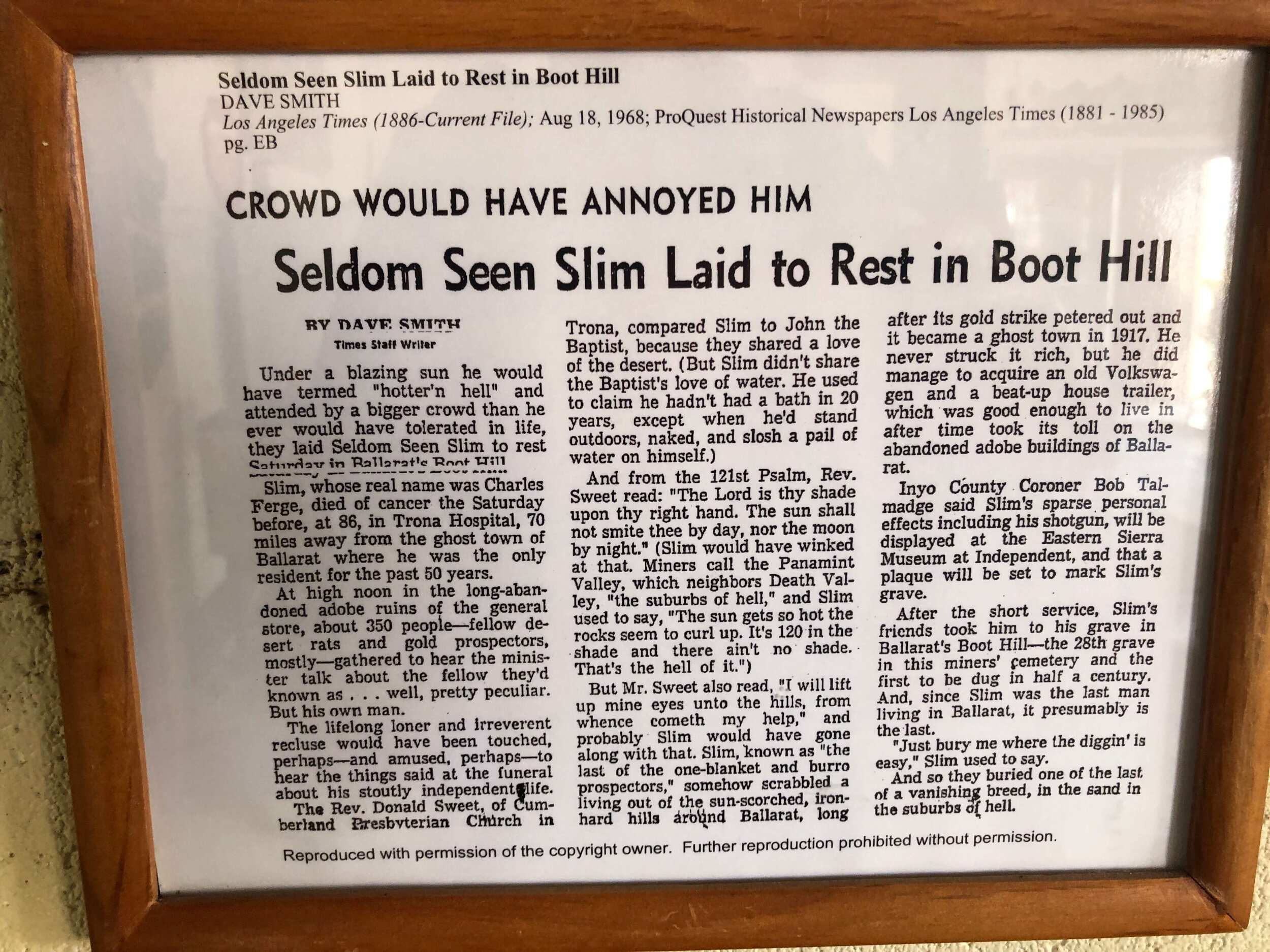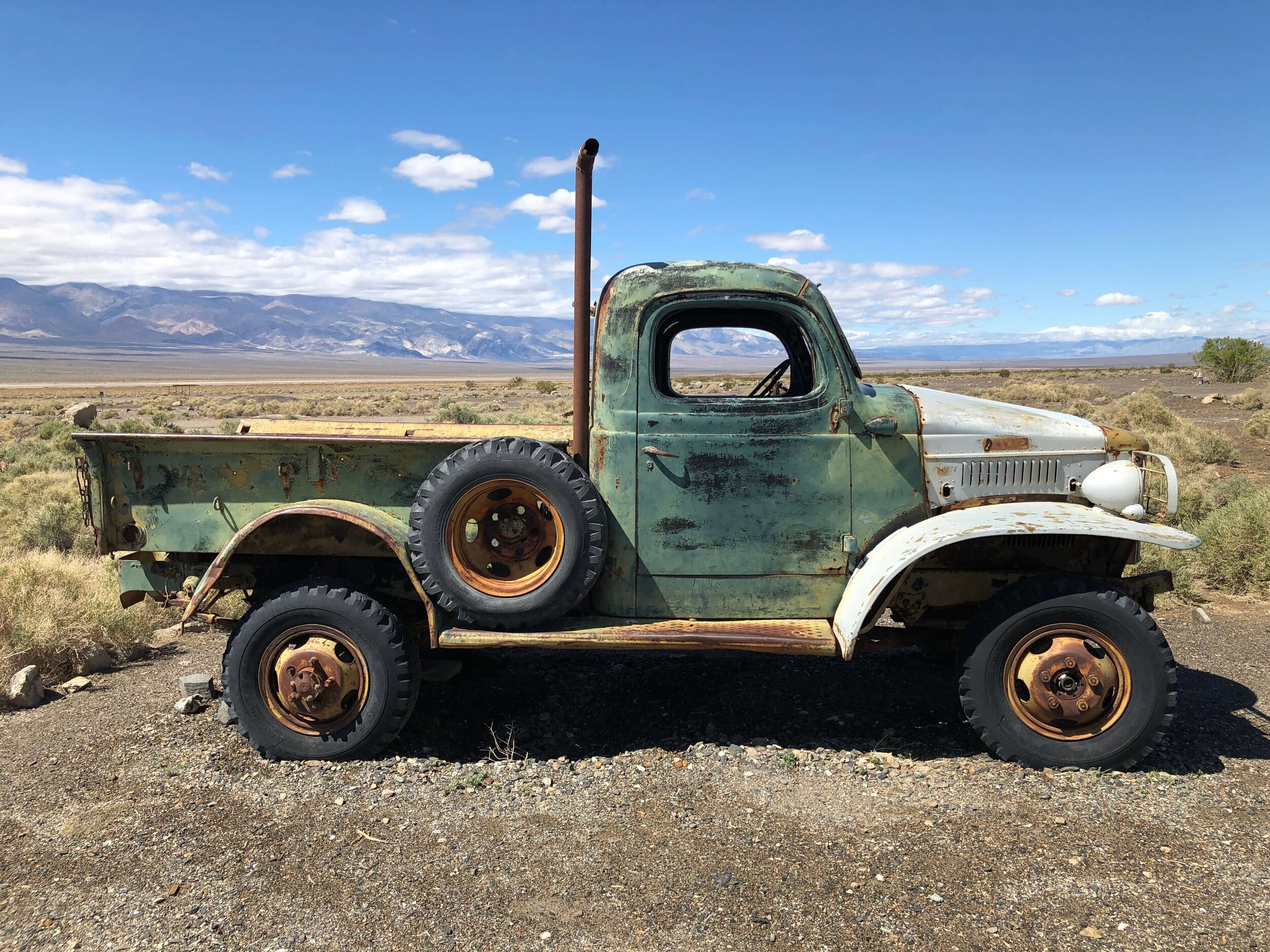How I Encountered Charles Manson’s Truck (Before a Mystifying Mantric “Coincidence.”)
Typical Death Valley roadside scene
So many of the people I care about are confined to their homes, consuming more bad news about the Coronavirus, and feeling stir crazy. Though it’s my fundamental personal mantra to “Be.Here.Now” (thank you, Ram Dass), it’s not so easy to focus on enjoying your circumstances if you’re confined to an apartment or home. So, come with me. We’ll take the time to relish what’s beautiful and remarkable all around us, like desert plants we might have passed right by without stopping to marvel at how they’ve managed to survive in this extreme environment.
Because I’m in California, I’m required by government rule to stay in my home, and I’m complying. My “home” is a Mercedes/Winnebago motorhome and the great outdoors around Death Valley National Park is where I’m staying.
That’s one benefit of the Coronavirus pandemic: It has driven me away from potentially infected or infecting people, out into Death Valley, with no TV; no radio; and no internet. Just time to think and look outside and inside.
This day’s adventure began a little dicey with a test of my Be.Here.Now mantra. It’s been my guide for decades, and especially right now.
On the way to Death Valley, I camped on BLM land (Bureau of Land Management - a U.S. government agency that allows RVers to camp freely for up to 14 days in forests and open prairies) north of Red Rock Canyon State Park.
The park itself is closed because of the Coronavirus, as are all of California’s State Parks. The only people who venture to this BLM land are dune buggy, dirt bike, and ATV people who come in their RVs and toy haulers for a weekend of tearing up desert landscapes with their motorized vehicles. (Arabs in the Middle East do it, too, and they call it “Wadi Bashing.”)
As swarms of high-pitched tinny-sounding dirt bikes buzzed like angry wasps on the hillsides around my hilltop campsite in the afternoon, I could feel the weather coming. Clouds darkened and gathered.
I’m in the habit of having chats with sunsets. My daily dialogs started in 1995 when I experienced an “Indian Sweat Lodge” ceremony. The “guide” said he was almost 1/64th native, which meant he was supposedly endowed with the spiritual wisdom to guide us through our experience.
In the pre-sweat orientation, he said, “During the ceremony, when you’re hottest and most uncomfortable, your Indian name will come to you.”
And mine did, though I misinterpreted the accentuation. I stumbled out of the lodge, dripping and dizzy, and announced that my name had come to me: “Sunset Watching George.” I liked it. I’m George, the guy who watches sunsets.
But that wasn’t it.
I had misinterpreted the verbal emphasis. Correcting it yielded the true meaning of my name: I’m George, and the sunset is watching me. And since then, for over twenty years, I’ve saved some time on most afternoons so I can answer to the sunset. Have I been good today? Did I help someone? Have I shown gratitude? Have I behaved with intellectual integrity and been fair and open-minded?
It’s my daily behavioral guide. I know I’ll need to answer those questions as the sunset watches me each day, and so I strive to behave accordingly. I always want to answer in the affirmative.
As the late afternoon clouds became threatening, I contemplated bailing out, moving away from my BLM hilltop perch and driving in the fading dusk, down closer to the paved road where I had a better chance of getting out of there. I even used a flashlight to plan an escape route in case it rained overnight and got muddy.
It rained and got muddy, all right.
Through the night, gale wind gusts rocked my RV, even though I’d extended the levelers. It rained. It rained. It rained.
I don’t use sedating drugs unless I’m flying across an ocean. Or, unless I’m wondering if my RV might be blown off a hilltop and slide down the slippery mud hillside and roll over, trapping me inside. I finally ingested an Ambien pill at 2:00 AM, calculating that I’d be awake for sunrise in five hours, which would be just past 7:00 the next muddy morning.
And that’s how it went, with a gorgeous 7:00 AM sunrise… and mud. No more rain. Just a lot of mud so slippy that it was hard to even walk without slipping and slopping.
I clomped around in my mudded boots, scouting for a route that might give me a slight chance of getting back to pavement rather than slipping off the muddy dirt road into a gully.
That’s when Be.Here.Now kicked in. The worst that could happen is that I’d be crushed and dead and the motorhome would never again take me on an adventure. That’s extremely unlikely to happen, so I just concentrated on being here and now. The desert’s dampened igneous rocks glistened. The leftover cloud clumps cast their moving shadows. And spaced far apart, a few purple and yellow wildflowers struggled to survive the storm, poking their tiny blossoms up through the desert dirt/mud. Be.Here.Now.
With just the right balance of speed and steadiness, wheels spinning and the butt end of the motorhome fishtailing, and that sound of mud clumps splattering up inside the wheel wells…
…I got out. Barely.
Relieved to be free of the possible entrapping quagmire, I continued down the deserted highway toward Death Valley.
The views every minute could grace the cover of any coffee table book about the Great American West and Death Valley.
That speck in the lower right is my RV.
I trust the Brown Sign Oracle to lead me when I’m in no hurry. Roadside viewpoints, historical markers, parks, and other notable sites are always indicated by brown signs. I let them guide me.
Leaving the BLM mudbath behind, I spotted an official Brownish Sign pointing to “Ballarat,” a ghost town an hour outside the entrance to Death Valley National Park. Of course I washboarded 3 1/2 miles toward the site of the old mine supply townsite.
Then I saw the unofficial welcome sign. Almost unreadable and home-made, yet pressed into a metal plaque so that it had endured through seasons of bitterly harsh climate. I barely made out what it said:
“BALLARAT”
(and an arrow pointed down the dirt road.)
”This is a free zone take any kind of picture you want camp party make movies etc no harm nobody cares feel free fear nothing.”
So with a welcome like that, of course I continued down the road to Ballarat.
I love to see old rusting mining machinery. There were plenty of gears and crushers and conveyor belt parts strewn around.
Rusting mining machinery
Rusty machinery
And, beside the discarded machinery, there was a trading post with two grizzled characters rocking on the front porch.
Their greetings were mere silent nods, so I went into their store. Lots of historic junk inside on the desiccated and splintering wooden shelves, but really nothing for sale.
The most fascinating “artifact” was a clipping from the Los Angeles Times about the passing of “Seldom Seen Slim,” who’d been the only resident of Ballarat for the last 50 years. I loved the headline about his memorial service: “Crowd Would Have Annoyed Him.”
Seldom Seen Slim article
Dusty Dan’s grave marker
The town’s prior long-term resident had been “Dusty Dan,” who died in 1948. His nearby grave marker read:
“Sur. by three wifes, fifteen offspring, two burro, and one dog.”
I then joined the rocking chair pair on their porch, quickly realizing that I was sitting too close, considering the Coronavirus social distancing guidelines. I moved my wooden chair several feet away. I sipped a cold soda, the only thing they had for sale. We didn’t talk much. I finally asked about the drive time to Vegas, which I guessed was about three hours. They had no idea. Never ventured that far from the ghost town, I guess. Not even far from those chairs on that old porch.
The old codger guy pointed to a rusted and battered Dodge truck. “That’s Charles Manson’s.” (And if you’re much younger than I am, you might not recognize the name of this horrifying demented demon of murder and terror. You’re better off not knowing.)
“My grandma owned the Barker Ranch, where he was arrested. So, after he went to prison and got all famous, we took the truck. That’s it.”
Charles Manson’s truck
As exciting as Ballarat was, I wanted to move along to Death Valley.
Death Valley National Park is shut down. No open visitor centers. Parking lots blocked off with barricades. The signs say that the National Park Service is concerned about the health of park staff, and so everything’s closed.
There was one private store open at Stovepipe Wells. No customers, though. A lovely lonely woman proprietor and I exchanged commentaries about what weird times these are. I asked if there were anyplace to camp nearby, since the park’s official campgrounds were all closed.
She directed me toward Furnace Creek, and said I’d see boondockers once I left the park. A boondocker, in RV parlance, is someone camping in the rough, with no hookups. No electricity or plumbing; self-contained only.
Crossing outside the park boundary, I found boondockers’ heaven, all right. This most welcoming site of another old mining operation is where I’m writing right now.
Though no mine structures are left, what must once have been a building’s foundation is now a perfectly level concrete slab with just the right amazing view.
I pay attention to what I do and don’t like in my life. I think it’s a pretty simple guide to living a life you love.
When I feel jubilantly happy, I take careful note of the circumstances surrounding me so that I can replicate that feeling. The opposite is true, too. When I’m unhappy, such as when traversing LA freeways in an RV or riding a Harley, I note my discomfort and arrange to not do much of that.
I like talking with strangers and letting them open up.
I like being on the road away from cities, where people wave to each other and smile as they pass.
I like being unsure of where I’ll end up for the night.
I like being surrounded with natural beauty.
I like witnessing slow-motion geology, such as a gigantic boulder that’s rolled halfway down an escarpment and will finish its roll in another couple of thousand years. (Ouarzazate, Morocco and Wadi Rum, Jordan are especially great places for those observations.)
I’d love to have a companion with whom I could share this kind of adventure. I’m alone, though, so I correct course and switch to Be.Here.Now mode. Why wish things were different when they’re already wonderful? Just BE. Carefully notice where HERE is. And never mind yesterday or tomorrow, just focus on NOW.
I didn’t make up any of this one-day account that I’ve captured in writing. It’s just what happens when I surrender to serendipity, follow Brown Signs, and expect that something wonderful will happen. This isn’t fiction or something I concocted to tell an interesting story.
When I first arrived here on this concrete slab, in this perfect spot, I gave my rig just enough throttle and trundled up onto the slightly elevated former foundation, activated my rig’s automatic hydraulic levelers, extended the slide, and opened the side door to find this painted on the concrete:
“Be. Here. Now.”
Things like this just happen to me. (A mantric coincidence?)


















